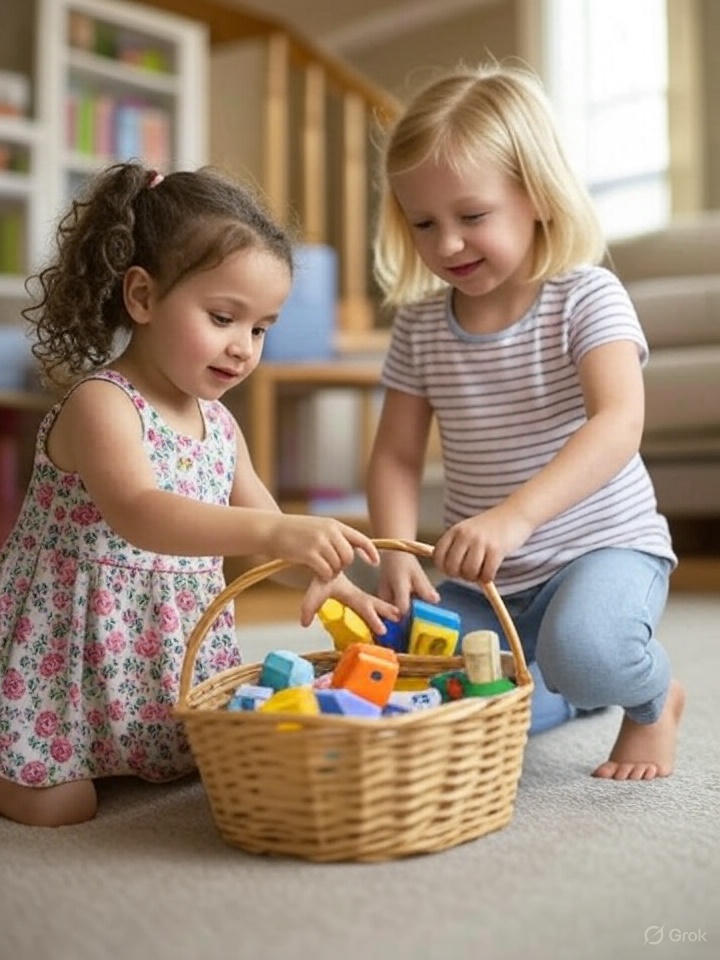Instilling a sense of responsibility in children through chores is more than just getting the dishes done or the room tidied.
When approached thoughtfully, teaching kids to tackle tasks they’d rather avoid can foster creativity, critical thinking, and a positive mindset toward challenges—skills that will serve them well into adulthood.
As a grandparent, I cherish the chance to approach daily situations with kids differently than I did as a young, inexperienced parent. Back then, I relied solely on my own childhood experiences, which often led to screaming, spanking, confusion, and frustration, breeding resentment and resistance. Kids lack the context or know-how for tasks like chores, and their unique personalities and learning styles add complexity. In this post, I share ideas to build trust and connection with your child while equipping them with tools for adulthood—without toxic, divisive conflicts.
The key is to transform chores from mundane obligations into opportunities for growth, self-expression, and problem-solving. Here are a variety of creative strategies to make chores engaging while nurturing these valuable life skills.
1. Reframe Chores as Creative Challenges
Children often perceive chores as boring or punitive because of how tasks are presented. By reframing chores as puzzles or creative projects, you can shift their perspective and spark curiosity.
How to Do It: Instead of saying, “Clean your room,” try, “Let’s design a space that feels like your own personal superhero headquarters!” Encourage them to think about how organizing their toys or books could reflect their personality. For example, they might group items by color, theme, or story, turning tidying into a design challenge.
Why It Works: This approach taps into a child’s imagination, making the task feel like a game rather than a duty. It also introduces critical thinking as they decide how to prioritize and categorize items.
Long-Term Benefit: Reframing challenges as opportunities encourages kids to approach problems with a solution-oriented mindset, a skill that translates to tackling complex tasks in adulthood, from workplace projects to personal goals.

2. Gamify the Process
Gamification can turn even the most dreaded chores into exciting adventures. By adding elements of play, competition, or rewards, you can make tasks feel less like work and more like a quest.
How to Do It: Create a “Chore Quest” board where tasks are missions with points. For example, vacuuming the living room might be “Defeat the Dust Dragons” for 10 points, while folding laundry could be “Tame the Clothes Mountain” for 15 points. Kids can earn points toward a small reward, like choosing a family movie or an extra 15 minutes of playtime. Alternatively, set a timer and challenge them to “beat the clock” for a specific task.
Why It Works: Games engage children’s natural love of play and competition, making chores feel less daunting. The structure also teaches them to break tasks into manageable steps, a key component of critical thinking.
Long-Term Benefit: Gamifying challenges helps kids learn to find joy in progress and completion, a mindset that can make tedious adult responsibilities—like taxes or administrative work—feel more manageable.
3. Encourage Ownership Through Choice
Giving children a sense of control over their chores can reduce resistance and foster independence. When kids feel like they have a say, they’re more likely to engage creatively with the task.
How to Do It: Offer a “chore menu” where kids can choose which tasks to tackle on a given day. For example, they might pick between washing dishes, sweeping the floor, or organizing the bookshelf. You can also let them decide how to complete the task—perhaps they want to play music while cleaning or invent a new system for sorting laundry.
Why It Works: Choice empowers children, making them feel like active participants rather than passive followers of instructions. It also encourages them to think critically about their preferences and strategies.
Long-Term Benefit: Learning to make thoughtful choices builds decision-making skills, which are crucial for navigating complex adult responsibilities, from career paths to time management.
4. Connect Chores to Storytelling
Kids love stories, and weaving chores into a narrative can make them feel like part of an epic adventure. This approach not only makes tasks fun but also nurtures creative thinking.
How to Do It: Turn chores into a story where your child is the hero. For instance, washing dishes could be “saving the kingdom’s treasure from the Grime Monster,” with each clean plate advancing the plot. Encourage them to add their own details to the story, like naming the villain or describing their “superpowers” (e.g., the power of the scrub brush). You can even have them draw or write about their chore adventure afterward.
Why It Works: Storytelling engages a child’s imagination and gives them a sense of purpose. It also encourages them to think creatively about how to describe and approach the task.
Long-Term Benefit: The ability to craft narratives around challenges helps adults reframe difficulties—whether it’s a tough work project or a personal setback—as part of a larger, meaningful journey.

5. Highlight the “Why” Behind Chores
Children are more likely to engage with chores when they understand their purpose. Explaining the deeper value of tasks helps them see chores as meaningful contributions rather than arbitrary demands.
How to Do It: Connect each chore to a bigger picture. For example, explain that keeping the kitchen clean helps the family stay healthy by preventing germs, or that organizing their space makes it easier to find their favorite toys. Ask open-ended questions like, “Why do you think it’s important to take care of our home?” to encourage reflection.
Why It Works: Understanding the “why” fosters empathy and critical thinking as kids consider how their actions impact others. It also helps them internalize the value of responsibility.
Long-Term Benefit: Adults who understand the purpose behind tasks are better equipped to prioritize and tackle responsibilities, whether it’s maintaining a household or contributing to a team at work.
6. Model Creative Problem-Solving
Children learn by watching the adults around them. By modeling a creative and positive approach to your own responsibilities, you can inspire them to approach chores with the same mindset.
How to Do It: Let your child see you tackle a task you don’t love with enthusiasm. For example, while doing laundry, you might say, “I’m going to make this fun by pretending I’m a scientist sorting colorful potions!” Invite them to join you in brainstorming ways to make the task more enjoyable, like turning it into a race or creating a silly song.
Why It Works: Modeling shows kids that even adults face tasks they don’t enjoy, but creativity can make them manageable. It also normalizes collaboration and brainstorming.
Long-Term Benefit: Observing creative problem-solving helps kids develop resilience and adaptability, skills that are essential for navigating life’s inevitable challenges.
7. Celebrate Effort and Innovation
Positive reinforcement can motivate kids to approach chores with enthusiasm and pride. Instead of focusing solely on the outcome, celebrate their effort and any creative twists they bring to the task.
How to Do It: Praise specific aspects of their work, like, “I love how you organized your books by size—that’s such a cool idea!” or “You worked so hard to get those dishes sparkling!” If they come up with a new way to do a chore, like a unique folding technique or a cleaning shortcut, acknowledge their ingenuity.
Why It Works: Celebrating effort and innovation builds confidence and encourages kids to experiment with new ideas. It also reinforces the idea that the process is as important as the result.
Long-Term Benefit: A focus on effort and creativity fosters a growth mindset, helping adults embrace challenges as opportunities to learn and innovate.
Chores as a Foundation for Lifelong Skills
Teaching children to do chores they don’t want to do is about more than a clean house—it’s about equipping them with the tools to approach life’s challenges with creativity, critical thinking, and a positive attitude. By reframing tasks, gamifying the process, offering choices, weaving in stories, explaining the “why,” modeling problem-solving, and celebrating effort, you can transform chores into opportunities for growth. These strategies not only make chores more palatable but also lay the foundation for a mindset that will carry kids into adulthood, where they’ll face countless tasks and challenges that require the same resilience and ingenuity. So, the next time your child groans about a chore, seize the moment to spark their imagination and set them on a path to creative problem-solving.
Have you discovered an effective way of addressing chores?
Share with us, in the comment section below, what has worked with your child. Share also, what has been your biggest challenge. Together, we can become the village that it takes to raise the future generation. Thanks!

